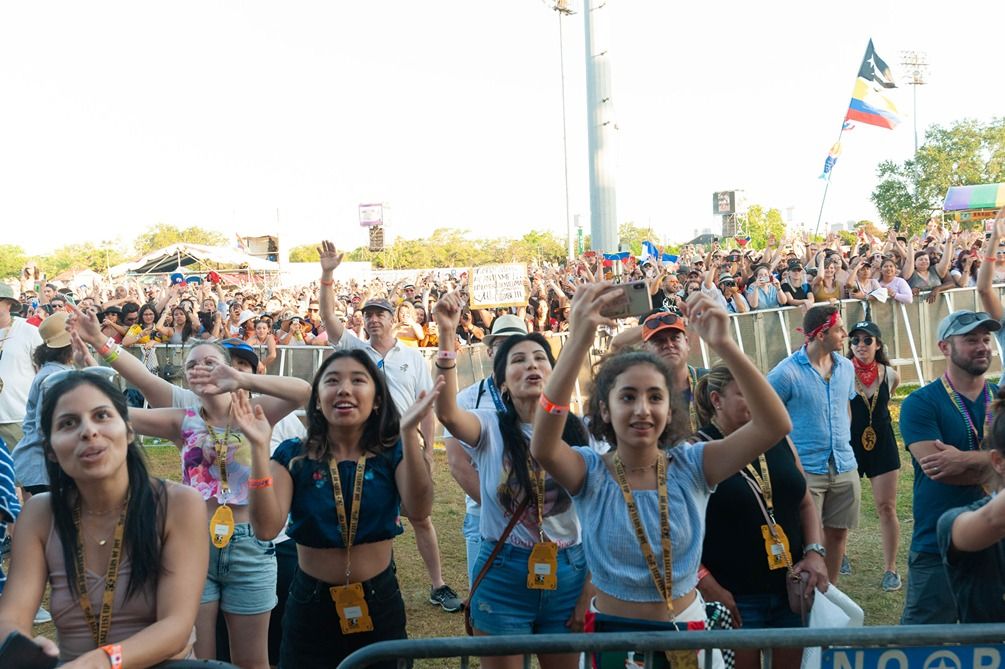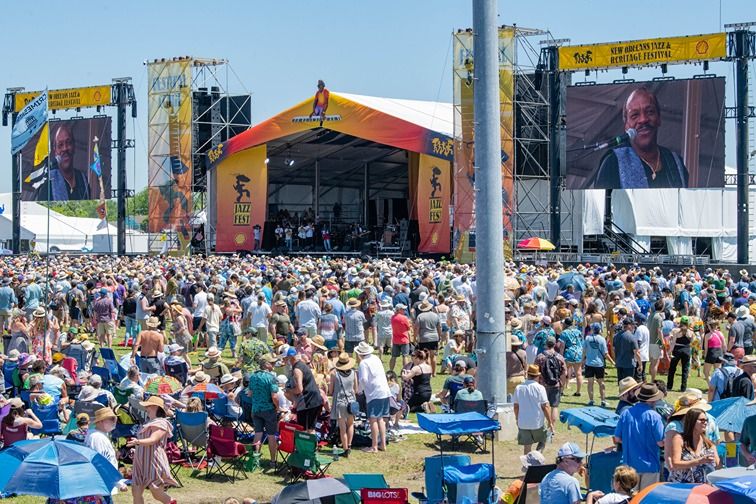Jazz Fest Celebrates All Music
This year's lineup for New Orleans' annual blowout concert series, popularly dubbed "Jazz Fest," is a real doozy, but it raises some questions. How did a festival that started with a minimal setup, devoted to authentic local jazz musicians and drawing a scant crowd of locals, grow into a bombastic spectacle that gathers musicians and fans from all genres into Mid-City each spring?
It's an achievement that only could have happened through cooperation, ingenuity, and rugged determination. Much like the city itself, Jazz Fest is a product of the people involved and their unique and individual ideas about music, culture, and community.
Let's take a look at some of the headliners we've had in the past. We have seen legendary singer-songwriter Tom Petty, who crafted indelible anthems with his band the Heartbreakers. There was Stevie Wonder, the piano prodigy who shaped the future of soul music while consistently landing on the pop charts with funk-inflected ballads. And then there's Maroon 5, a rock group from L.A. whose music has shifted in recent years toward expertly-produced pop; and Harry Connick Jr., arguably the most successful Sinatra-style crooner in today's music landscape. Rounding out others lineup have been rock acts like Kings of Leon, Dave Matthews, and Alabama Shakes; rappers Snoop Dogg and Pitbull; and blues/funk acts like Buddy Guy, The Meters, and Tower of Power. So the question looms: when did "Jazz Fest" become a music festival, rather than a jazz festival? And is that necessarily a bad thing?

More Than Jazz
To skip ahead a bit: no. It isn't a bad thing. The headliners may not cleanly fit into anyone's definition of what jazz music is, but they draw in people who may be unfamiliar with the dynamic, vibrant art of jazz and the associated culture of New Orleans, and many of those people leave with a better understanding of the city, the music, and the people who strive to keep it alive. The teenage brass bands that gather huge crowds on Frenchmen Street, the sidewalk saxophonists playing their hearts out for a few bucks, the bassists and drummers perfecting their rhythm nightly on the city's bar circuit: all of these people both benefit from and help create Jazz Fest. And all of this energy stems from the festival's origins, as a defiant, unique attempt at reinvigorating a cultural tradition that had grown stagnant.
The festival's success has come in large part from its organizers' willingness to defy traditional ideas about structure, lineup, and genre, something that started at the inauguration of the event in 1970. Jazz festivals at the time were not popular, even in the city where the movement found its footing. The few that existed were mostly in the North, held at music conservatories and attended by pedantic scholars, eager to spot a wrong note or an incorrect take on a standard. The producers of the first Jazz Fest stepped outside of that framework in an attempt to create something more organic, a concert series that captured the passion and commitment of New Orleans's musicians and drew in locals to watch, rather than stuck-up academics.

In the Beginning
Producer George Wein and his associates, Allison Miner and Quint Davis, are credited with crafting the first Jazz Fest and thereby shaping its future. Wein had established himself as the producer of festivals for jazz and folk in Newport, Rhode Island, but the New Orleans event was the biggest thing he had tackled thus far. Allen and Davis spent a great deal of time in black clubs around the city, finding performers based on word of mouth. This was a break from the way jazz festivals were curated in the past, in which contest winners and highly decorated collegiate groups were selected based on their reputation among the intelligentsia. By delegating the duty of selecting performers to these two young music enthusiasts, Wein inadvertently created the anything-goes attitude toward curation that carries on to this day.
Davis and Miner made every effort to find performers who were authentic, local, and in many cases, self-taught; their committee of advisers included Ellis Marsalis and Tulane jazz curator Dick Allen, who pointed them to clubs where performers packed the house weekly but received little nationwide recognition. Tellingly, their first hire was Snooks Eaglin, whom they found singing on the street for tips; he became a fixture at Jazz Fest in the following years. And Eaglin hardly qualified as a jazz singer; the festival, even in the beginning, had a wide definition of "jazz." Anyone confused about the diverse contemporary lineup ought to look at the original list from 1970: performers like The Meters and Mahalia Jackson clearly fell outside the boundaries of traditional jazz, but they still fit the bill for a concert series that highlighted the spirit of New Orleans above all else.

A Lasting Legacy
Wein and his backers held the first Jazz Fest in Congo Square, and the crowd wasn't huge: around 350 people paid the $3 admission fee. But an attitude of perseverance took hold among the festival's organizers and backers, who saw how enthused the people of New Orleans were at seeing their favorite local performers on a larger stage. By 2001, the festival was drawing 650,000 people from across the country. There are now 12 stages at Jazz Fest and tents devoted to blues, gospel, and jazz. Purists can stay in one location and experience hours of authentic New Orleans jazz, while those with more eclectic tastes can wander from place to place, seeing a bit of a chart-topping pop singer's performance before ducking into a tent to catch a set from a fiery local brass band.
Jazz Fest is not, and has never been, limited to jazz. Instead, it celebrates everything jazz represents. Like the music itself, the festival was improvised and off-the-cuff from its inception and continues to be as thrilling and unpredictable as the city that birthed it. This year, the festival runs from April 25-May 5, with tons of associated concerts and events throughout the city.

